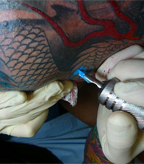Case Report Shows Tattoos May Hide Melanoma
Melanoma can hide in pigmented tattoos, according to a new case report describing a young man with a malignant melanoma that developed within a large tattoo.
Melanoma may be hiding in pigmented tattoos, according to a new case report published in JAMA Dermatology. Clinicians from Germany recently published a case report detailing a young white man with a malignant melanoma that developed on a nevus within a large tattoo.

The clinicians, led by Laura Pohl, MD, of Laserklinik Karlsruhe, Germany, reported the case in the hope that other colleagues may help them to gather additional information on similar cases of melanoma developing within tattoos, in addition to the 16 cases already reported in English literature.
“Pigmented lesions in decorative tattoos cause diagnostic difficulties at a clinical and dermoscopic level. In cases of laser removal of tattoos, hidden suspicious nevi may be revealed gradually,” the researchers stated.
According to background information in the case, “the number of decorative tattoos has been increasing, as has the demand for their removal by laser devices.” In this case, a man aged 29 years presented to the clinic for removal of large tattoos that covered most of his chest and arms.
Upon examination of his skin, the clinicians noticed a nevus on his shoulder and advised that it be excised. However, the patient refused excision.
With informed consent, the clinicians began removal of the tattoos in March 2002 with a Q-switched Nd:YAG laser, switching to a Q-switched alexandrite laser after loss of response after 43 sessions.
By November 2009, the clinicians refused to continue laser removal of the tattoo without excision of the nevus. The patient consented.
“At that time, dermoscopy findings showed characteristics of an early melanoma,” the clinicians wrote. “The excisional biopsy results showed the lesion to be a Clark level II malignant melanoma with a Breslow thickness of 0.45 mm.”
Based on their experience with this case, the Dr. Pohl and colleagues made several recommendations. First, skin examination should take place prior to laser tattoo removal, and, if suspicious nevi are found, treatment should be withheld until excision occurs. In addition, clinicians should continue to conduct skin examinations throughout the process of laser tattoo removal. Finally, the clinicians recommended that tattoos never be placed on a pigmented lesion in the skin.
Newsletter
Stay up to date on recent advances in the multidisciplinary approach to cancer.